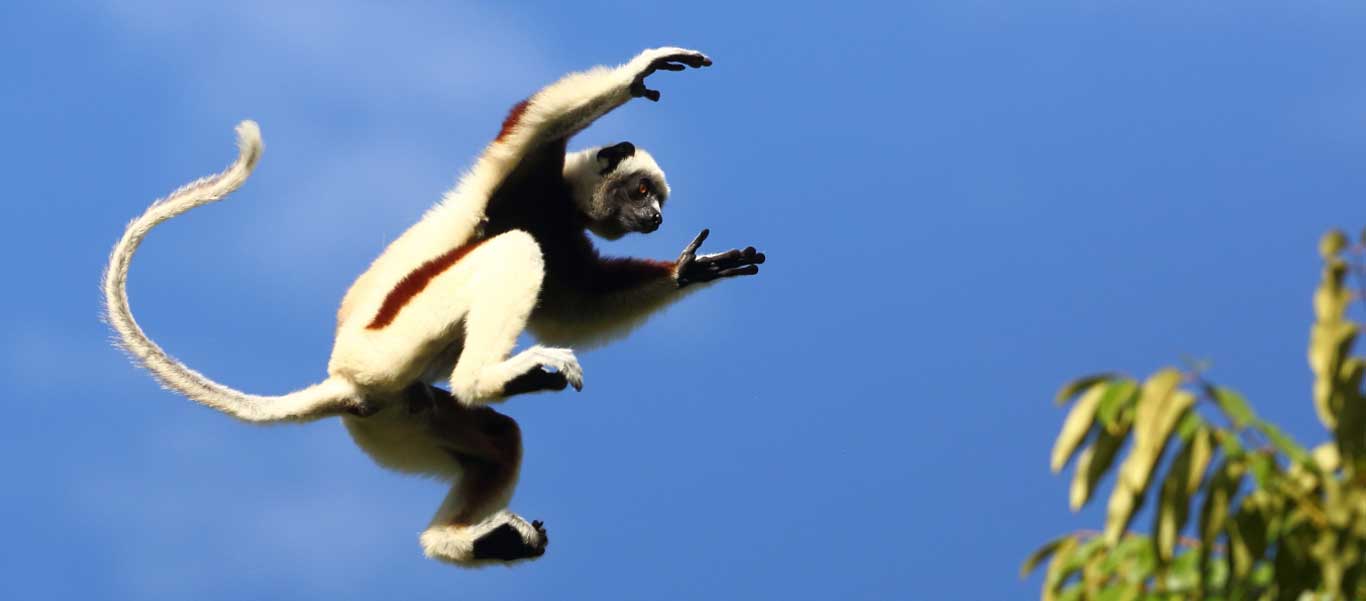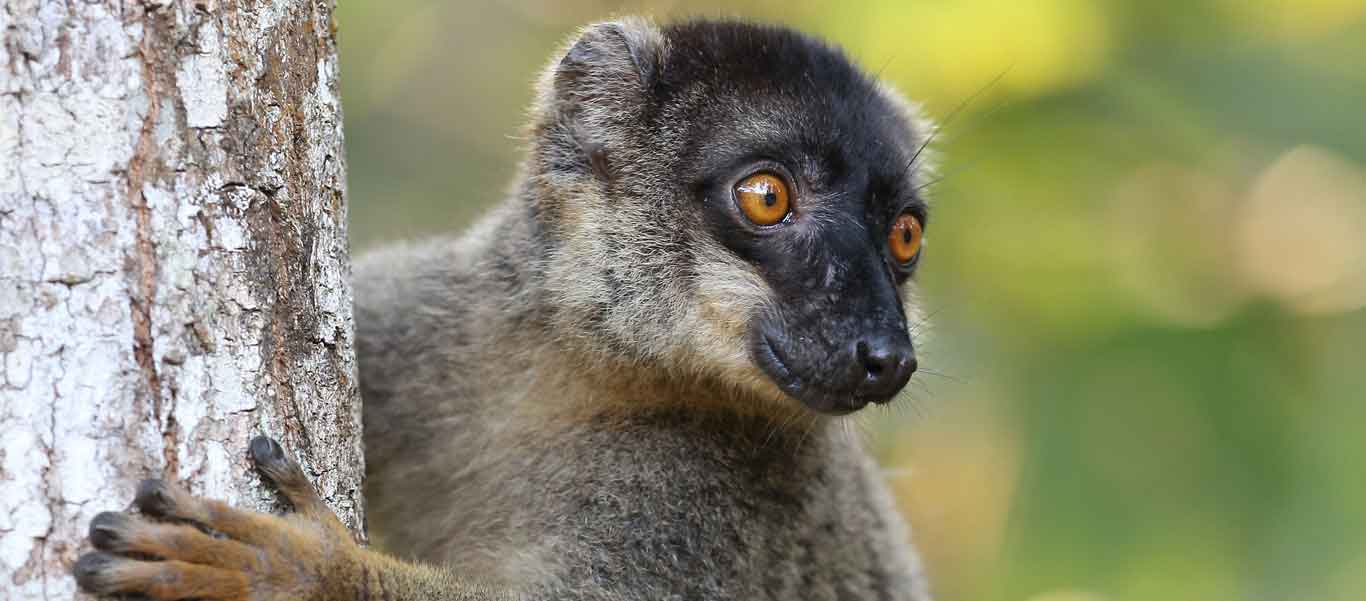Madagascar
October 9 – 20, 2026
Madagascar Safari
Madagascar is home to one of the most unusual wildlife assemblages on Earth, its exceptional fauna and flora having evolved over millions of years of isolation. This Madagascar safari reveals a remarkable diversity of habitats, on an island often referred to as “The Eighth Continent.” Madagascar’s legendary uniqueness is best reflected in its mammals, with every one of its 150 native terrestrial species being found nowhere else on the planet! Most famous as the home of the lemurs, with an amazing 106 species divided over five endemic families, the island also boasts a host of colorful chameleons, a plethora of glamorous amphibians, and fascinating flora. Madagascar’s endemic birds are equally renowned, with no fewer than 140 species and 5 complete families entirely restricted to this “laboratory of evolution.” Join us on this Madagascar tour and discover the world’s greatest wildlife destination.
Destinations
- Travel by Air
- Travel by Road
- Travel by Boat
- Travel by Bullet Train
- Travel by Rail
- Travel by Dog Sled
-
Antananarivo
Arrive in Antananarivo (Tana), Madagascar, this evening for a welcome dinner and briefing with your expedition leader and fellow travelers. Driving into Tana one is struck by the stark differences from the African continent: rice paddies, worked by men and their Zebu ox-drawn ploughs, flank the city, with the architecture a combination of French colonial and traditional Merina, all of which imparts a strangely Asian feel to an island so close to the African mainland. Dinner and overnight at the Relais de Plateaux on the outskirts of Antananarivo.
-
Antananarivo
Today, explore the Royal Hill of Ambohimanga, a UNESCO World Heritage Site. This site was first settled in the 15thcentury and established as a political capital and royal palace complex during the reign of King Andriantsimitoviaminandriana in the 18th century. To this day it’s still an important cultural and spiritual site for many Malagasy people. This afternoon, visit a local market. Dinner and overnight at the Relais de Plateaux.
-
Berenty Reserve
After breakfast, board your flight to Ifotaka, then transfer to Berenty Private Lemur Reserve. On the transfer to Berenty, you’ll notice that the native vegetation has been replaced by extensive sisal plantations, stretching as far as the eye can see. Berenty Private Lemur Reserve is an island of natural habitat in this sea of cultivation, and one of Madagascar’s most legendary wildlife sanctuaries. Berenty is justly famous for its lemurs, not only because its deciduous gallery woodland is home to six species, but particularly for the ease with which they can be seen and appreciated in the wild. Undoubted favorites are the Ring-tailed Lemurs and Verreaux’s Sifakas. The bands of cat-like, quizzical Ringtails are often the first to steal any visitors’ hearts, but their appeal is easily matched by the strikingly-patterned Sifakas, with their soulful expressions and bipedal locomotion. In addition to these two diurnal lemur “super-stars”, Red-fronted Brown Lemurs also occur in large numbers in the woodland. Overnight at Berenty Lodge.
-
Berenty Reserve
Although Madagascar is most famous for the spectacular lemurs that have adapted to a daytime existence, a number of species of these primitive primates remain denizens of the night. On spotlighting walks in the “spiny forest” adjacent to your lodgings, search for White-footed Sportive Lemurs and two species of Mouse Lemurs. A further highlight at Berenty is a roost of Madagascar Flying Foxes, where over 300 of these impressive fruit bats, sporting four-foot wingspans, spend their day jostling for position in the treetops. Amongst the birds, the pheasant-like Giant Coua is often encountered stalking along the paths, whilst both the camouflaged Madagascar Scops-Owl and the handsome White-browed Hawk-Owl are commonly found asleep at their day roosts in the gallery woodland. Reptiles are well represented by the bizarre Three-eyed Lizard and huge Warty Chameleon. Overnight at Berenty Lodge.
-
Andasibe-Mantadia National Park
After a final morning at Berenty, return to Ifotaka and board your flight back to Tana. On arrival, turn eastwards for the drive across the open landscape of the Horombe Plateau, which offers insight into the traditional lifestyle of the highland Merina people. Terraced rice paddies, tall earthen houses with thatched roofs, and roadside markets displaying a wide variety of farm produce, are all set against a backdrop of golden-yellow grasslands and bare granite inselbergs. By the afternoon, you’ll arrive in the small town of Andasibe, or Perinet as it’s still commonly known, gateway to the magical Andasibe-Mantadia National Park. Your accommodation for the next two nights is a delightful lodge, located overlooking a lake at the edge of the forest. Wildlife is often right on your doorstep: fluorescent green day geckos scuttle on the walls of the chalets, Madagascar Wagtails flit along the paved walkways, and if you are very lucky, you may hear the eerie calls of Indri right from your cabin. Overnight at Vakona Forest Lodge.
-
Andasibe-Mantadia National Park
You’ll have two full days in the superb Andasibe-Mantadia National Park, which protects a large expanse of some of Madagascar’s most pristine primary forest, a sanctuary for the richest assemblage of birds and other wildlife on the island. Though it has only relatively recently been opened to the public, the slightly higher-altitude Mantadia sector is now an essential destination on any trip to Madagascar, having gained a reputation as an excellent site for a handful of scarce forest-dwelling lemurs. Not least amongst these is the exquisite, gentle, and highly localized Diademed Sifaka, although you will also be searching for the more widespread Black-and-white Ruffed Lemur, Gray Bamboo Lemur, Red-bellied Lemur, and Common Brown Lemur. The Andasibe-Mantadia area is also a rewarding site for nocturnal exploration, with such charismatic nocturnal lemur species as Eastern Woolly Lemur, Furry-eared Dwarf Lemur, and the diminutive Goodman’s Mouse Lemur all possible, along with a plethora of chameleons, geckos, and frogs. Overnight at Vakona Forest Lodge.
-
Andasibe / Antananarivo
This morning, make a special effort to see the park’s most famous resident: the huge, singing Indri, largest of all extant lemurs. Standing beneath a family group of these magnificent creatures as they issue their peculiar, Humpback Whale-like songs is one of Madagascar’s most unforgettable wildlife experiences. While the rainforest lemurs are the undoubtedly highlights of your time in the Perinet area, you will also be on the lookout for a profusion of smaller evolutionary oddities, like the peculiar Giraffe-necked Weevil, the impossibly cute Lowland Streaked Tenrec, the seriously weird Sikora Leaf-tailed Gecko, Madagascar Tree Boa, and the giant Parson’s Chameleon, heaviest chameleon species on Earth. Andasibe-Mantadia also offers the best rainforest birding in Madagascar, and you can expect to see such avian jewels as Blue Coua, Blue Vanga, and Madagascar Cuckoo-Roller. In the afternoon, retrace your route to Tana, overnighting at the Relais de Plateaux.
-
Anjajavy
Fly northwestwards to your final destination in Madagascar, the magnificent wilderness of Anjajavy, for a three night stay at Anjajavy Lodge.
-
Anjajavy
Situated on the island’s northwest coast, in the so-called Sambirano Domain, this 1,000-acre private reserve covers a ruggedly beautiful area of secluded bays flanked by baobab-studded semi-deciduous forest. Wildlife is abundant, with the ethereal Coquerel’s Sifaka, boisterous troops of Common Brown Lemur and flocks of brilliant-green Grey-headed Lovebirds resident right in the grounds of your comfortable lodge. Nearby caves in the limestone karst boast the fossilized remnants of a long-extinct lemur, as well as an impressive collection of stalagmites and stalactites. Spend time along the forest trails, where Collared Iguanas loaf in sunny spots and Madagascar Plated Lizards scuttle through the leaf litter. With luck, you may locate the goblin-like Milne-Edwards’s Sportive Lemur at its day roost in a tree cavity. Explorations after dark are equally productive and may reveal the eye-shine of a darting Golden-brown Mouse Lemur, Madagascar Nightjar hawking for insects or perhaps a sleeping Warty Chameleon. Overnights at Anjajavy Lodge.
-
Antananarivo
After a final early morning at Anjajavy, fly back to Antananarivo in time to connect with international flights homeward.
Details
- October 9 – 20, 2026
- Leaders Marco Tonoli & Joffers (Jonathan) McCormack
- $17,980 Per Person Rate
- $19,970 Solo Rate
- 12 days Trip Length
- 14 guests
- Antananarivo Start/End
Call us to reserve your spot on this exciting expedition!









